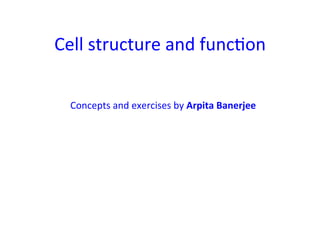
Cell
- 2. Learning goals: • Cells as structural and func.onal units of an organism. • What defines a cell? • What cons.tutes a cell? What is the role played by each of the cons.tuents? • How do cells perform their func.on? • How do cells connect with other cells to perform a specific func.on? • How do cells interact with their environment and neighbors to elicit a par.cular cellular response? Cell structure and Func7on Arpita Banerjee
- 3. 1. Cells are structural and func.onal units of organisms, meaning they are like building blocks from which organisms are made. 2. Cells collec.vely form .ssues. 3. Tissues in turn form organs or different parts of an organism. 4. Cells have gene.c informa.on (DNA/RNA) encoded within them. The cell oNen taps into this informa.on for carrying out its func.on and for regenera.on Cell structure and Func7on Warm up Arpita Banerjee
- 7. 1) What defines the boundary of a cell for it to be a separate unit? 2) What is a cell composed of? 3) How does a cell generate energy for running its machinery? LBQ – Learn by ques.ons Cell structure and Func7on Arpita Banerjee
- 21. Exercise: Mul.ple Choice ques.ons 1. Where is the gene.c material of an organism stored in the cell? (a) Mitochondria (b) Nucleus (c) Mitochondria and nucleus (d) Ribosome (e) cell membrane 2. Which organelle in plant cells carry out photosynthesis? (a) Mitochondria (b) Nucleus (c) Mitochondria and nucleus (d) Chloroplast (e) Endoplasmic Re.culum. 3. Where does protein synthesis occur in cells? (a) Mitochondria (b) Nucleus (c) cell membrane (d) Chloroplast (e) Endoplasmic Re.culum. 4. How does cell wall differ from cell membrane in plant cells? Check all that are true. (a) Cell walls are harder and less permeable (b) Cell walls are harder and more permeable (c) Cell membranes are harder and less permeable (d) Cell membranes are harder and more permeable. (e) Cell membranes are soNer and less permeable. 5. What will happen to a cell when placed in a salty solu.on? Check all that are true. (a) The cell will absorb water and swell (b) The cell will release water and contract (c) The cell will absorb water and contract (d) The cell will release water and swell (e) The cell will remain the same. Cell structure and Func7on Arpita Banerjee
- 22. Exercise: Fill in the blanks 1. ------------ is the barrier between the cell and its environment. 2. Rough Endoplasmic Re.culum has ------------ on it. 3. Protein synthesis occurs in --------- Endoplasmic Re.culum 4. The func.on of a cell would vary as per the --------. 5. Cell divides to form two --------- cells. Cell structure and Func7on Arpita Banerjee
- 24. Exercise: True or False 1. Cells allow everything from the outside to pass through them. 2. Animal cells contain large vacuoles. 3. ATP (energy molecule) synthesis occur inside the mitochondrion. 4. Nucleolus is the gene.c material mass inside the nucleus. 5. Centrosome has a role in cell division. Cell structure and Func7on Arpita Banerjee
- 26. Answer the following: (Factual ques.ons) 1) Which cell has a large vacuole – plant cell or animal cell? 2) Which organelle produces energy currency of cell? 3) Which is more permeable – cell wall or cell membrane? 4) What is the func.on of Golgi apparatus? 5) Does nucleus has a membrane? Cell structure and Func7on Arpita Banerjee
- 30. Suppose the cell in the picture receives a signal from another cell to produce a par.cular protein in abundance and export the newly synthesized proteins out of the cell for performing a certain func.on. Now answer the following ques.ons. 1) Where would the cell receive the signal? (a) Mitochondria (b) cell coat (c) plasma membrane (d) Ribosome (e) Lysosome. 2) Where does the signal needs to be transmiOed to? (a) Mitochondria (b) cell coat (c) Endoplasmic re.culum (d) Nucleus (e) Lysosome. 3) Where would protein synthesis occur in response to the signal? (a) Mitochondria (b) Smooth endoplasmic re.culum (c) Rough endoplasmic re.culum (d) Nucleus (e) Lysosome. 4) Where would protein folding occur? (a) Cell coat (b) Smooth endoplasmic re.culum (c) Rough endoplasmic re.culum (d) Golgi apparatus (e) Lysosome. 5) Where would the newly formed protein get trafficked to immediately aNer synthesis? (a) Cell coat (b) Smooth endoplasmic re.culum (c) Rough endoplasmic re.culum (d) Golgi apparatus (e) Ribosome. Arpita Banerjee